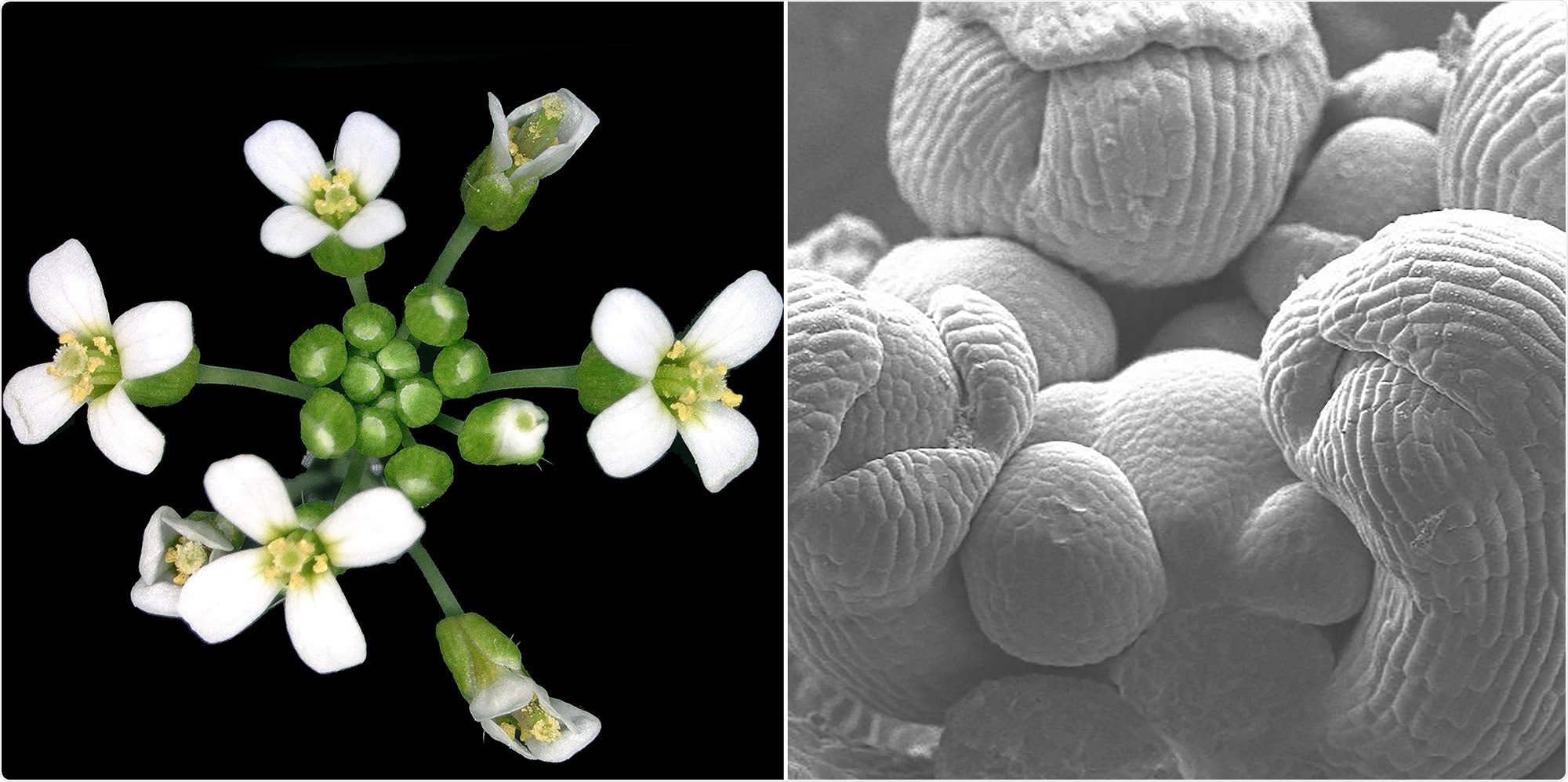The mechanism through which cytokinin—a plant hormone—regulates the division of cells has been identified—a discovery that considerably enhances one’s understanding of how plants normally grow.

Arabidopsis thaliana shoot apical meristem with multiple flowers radiating out from the center at different stages of development (left) and the shoot apex under a scanning electron microscope where the center area contains stem cells and is surrounded by young flower primordia (right). Image Credit: Weibing Yang.
Cell division is integral to all forms of life—all multi-cellular organisms, such as animals and plants, evolve from a single cell that splits billions of times to constrict a complex organism. Within the plants, undifferentiated stem cells serve as a reservoir of new cells from which the plants can eventually grow and develop specialized tissues.
New roots, new stems, new leaves, and new flowers all emerge from tiny groups of stem cells in growth regions, known as apical meristems.
Within these growth regions, the cells are constantly dividing in a process known as mitosis, which constructs the architecture of the plant. For a long time, researchers have known that cytokinin is crucial to these functions of cell division in plants, however without knowing how it activates the proliferation of cells.
For the first time, the researchers from the Sainsbury Laboratory at the University of Cambridge and the California Institute of Technology demonstrate how cytokinin stimulates the division of stem cells in plants. The article has been published in the Science journal.
With the help of Arabidopsis thaliana—a member of the mustard family often used as a model plant in plant science studies— the researchers demonstrated that cytokinin directly supports the transport of the transcription factor, called MYB3R4, from the cytoplasm to the nucleus, where it stimulates the expression of crucial cell cycle genes.
Understanding how stem cell self-renewal is controlled is crucial for understanding plant growth and development. We knew the plant hormone cytokinin was important, and our research now explains the mechanism by which cytokinin regulates stem cell division – it does this by shuttling proteins into the nucleus where they activate genes involved in mitosis.”
Dr Weibing Yang, Group Leader, Centre of Excellence for Plant and Microbial Science
Dr. Yang performed the study at the University of Cambridge as the lead author of the paper.
During mitotic cell division or mitosis, chromosomes replicate and later separate equally into two daughter cells.
Using time-lapse confocal microscopy of live plants, we were able to capture cellular dynamics of proteins that were found to be important for triggering mitosis.”
Dr Raymond Wightman, Study Co-Author, Imaging Core Facility Manager at Sainsbury Laboratory
Dr. Yang added, “Time-lapse observation of individual cells revealed rapid changes in MYB3R4 protein location. Prior to cell division, the protein was predominantly in the cytoplasm, and at the onset of mitosis, there was a rapid accumulation of MYB3R4 in the nucleus, followed by the protein being exported back into the cytoplasm at the completion of cell division.”
It has been known for more than 40 years that plant endogenous cytokinin level fluctuates during the cell cycle, and peaks at the G2/M transition. We have now shown that a direct response of this cytokinin peak is MYB3R4 nuclear trafficking. We have now shown that a direct response of this cytokinin peak is MYB3R4 nuclear trafficking.”
Dr Weibing Yang, Group Leader, Centre of Excellence for Plant and Microbial Science (CEPAMS)
Additional experiments demonstrated that cytokinin acts as a “molecular switch” that activates a positive feedback loop—it supports MYB3R4 nuclear localization to stimulate the transcription of importin genes, called IMPA3 and IMPA6, which consequently act to allow the import of MYB3R4 nucleus.
According to Henrik Jönsson, professor, study co-author, and director of the Sainsbury Laboratory, “With mathematical modeling, we demonstrate that this positive feedback can cause MYB3R4 nuclear trafficking to become both faster and stronger.”
Dr. Yang added, “Our findings may have practical applications. Through mutating the nuclear export signal, we were able to engineer a constitutively nuclear-localized MYB3R4 protein, and found that it could greatly enhance stem cell proliferation and meristem growth, partially mimicking the effect of cytokinin treatment.”
Elliot Meyerowitz, the study co-author, professor, and investigator from Howard Hughes Medical Institute added, “Increased cytokinin in the shoot meristem is one of the results of increasing nitrogen nutrition at the roots. Being able to increase the cytokinin cell division response in the meristem may provide a way to have plants grow as if they were well-fertilized, even when nitrogen levels in the soil are suboptimal. ”
By allowing a better understanding of how plant cells divide during their growth process, fundamental plant science such as this study could help identify new ways to improve the growth of plants and establish set a basis for upcoming studies that can influence plant health and agricultural yield.
Source:
Journal reference:
Yang, W., et al. (2021) Molecular mechanism of cytokinin-activated cell division in Arabidopsis. Science. doi.org/10.1126/science.abe2305.